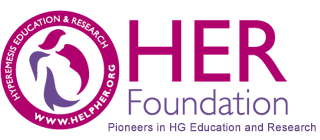Parenteral (Intravenous) Nutritional Therapy
After several weeks of vomiting,
you can become very malnourished, yet this may not be realized
by health professionals who only see you periodically. This
is especially true if you are above your ideal body weight
prior to pregnancy. TPPN (Total Peripheral Parenteral
Nutrition)
or TPN (Total Parenteral Nutrition) may be ordered
by your physician to ensure you receive adequate nutrition.
TPPN supplies
many more nutrients than basic IV fluids, and may be given
in a regular (peripheral) IV in the arm. However, the IV
will typically only last for a few days and will then need
to be
replaced.
TPN supplies most of you daily nutritional requirements
and is usually given through a catheter called a PICC line
placed in the arm, or a central venous line placed in the
neck/shoulder area. Local anesthetic is given to minimize
pain during the
procedure. These catheters are much longer and the end point
is in the heart. This allows very concentrated nutrients
to be given without damage to the smaller blood vessels of
the
arms. It is important to note that TPPN/TPN is not a complete
formula. Added multivitamins are very important to avoid
nutritionally-related complications.
Management of HG with Parenteral Nutrition
Once you lose over 5% of your pre-pregnancy body weight, nutritional therapies should be discussed, especially if you continue to have significant nausea, vomiting, and weight loss. At a minimum, IV home therapy with added vitamins should be administered after a few weeks of frequent vomiting. Once you lose 8-10% of your body weight or have been vomiting for more than a month, it is imperative that you receive support to replace the many nutrients you have lost and to maintain your hydration. TPPN or TPN is the next choice for ongoing replacement. Dehydration perpetuates the vomiting cycle, as do nutritional deficiencies. If nutritional support is not offered and/or you are not responding to anti-vomiting medications, a second opinion with a specialist may be needed.
See our Referral Network for tips on finding a doctor experienced in treating HG. You may need a friend or spouse to advocate for you while you are sick.
Medications v. Parenteral Nutrition
While nutritional support is important, some physicians initiate home TPN without having first attempted an adequate trial of antiemetic medications. Serious complications are possible when central venous lines are placed, as well as metabolic and infectious complications. These are usually due to insertion technique, improper care of the IV site or line, or inadequate monitoring of your metabolic and nutritional status with blood tests. However, these problems are estimated to occur in only a small percentage of women with HG, even when TPN is given at home.
Before TPN is begun, consideration should be given to aggressive anti-vomiting medications and home IV therapy with vitamins, which do not put you at risk for any life-threatening complications. A growing number of women report that drugs from the serotonin antagonist category (e.g. Zofran, Anzemet, Kytril) have been used in higher doses in their subsequent pregnancies, eliminating the need for TPN and even IV's in some cases. Many physicians (and midwives) are not familiar with the use of these drugs during pregnancy, and are reluctant to offer them in adequate doses (and early enough) to give mothers relief from incessant vomiting. Feel free to refer your health professionals to our site for assistance or find a physician up-to-date on caring for mothers with hyperemesis.
| Most Common Complications of Parenteral Nutrition | |
| Metabolic complications: | |
| Hyperglycemia | Increased glucose levels. Very common complication of parenteral nutrition. Close monitoring is important during pregnancy, esp. if using glucocorticoid (steroid) therapy. |
| Hypoglycemia | Decreased glucose levels. Most commonly related to abrupt discontinuation of TPN. |
| Essential fatty acid deficiency | May result from parenteral nutrition regimen without intravenous fat (lipid) administration. Replacement is important during pregnancy. |
| Electrolyte imbalance | Inadequate or excess administration of electrolytes (sodium, potassium, etc.) in parenteral nutrition solutions. Losses also occur due to vomiting. |
| Fluid volume disturbances | Volume deficit or volume overload (particularly important in pregnancy to maintain uterine flow). |
| Mechanical complications: | |
| Catheter related | Clots, infection, etc. |
| Site related | Pain, inflammation, or redness. |
Updated on: Sep. 15, 2022




 The Chronicles of Nausea
The Chronicles of Nausea Beyond Morning Sickness
Beyond Morning Sickness